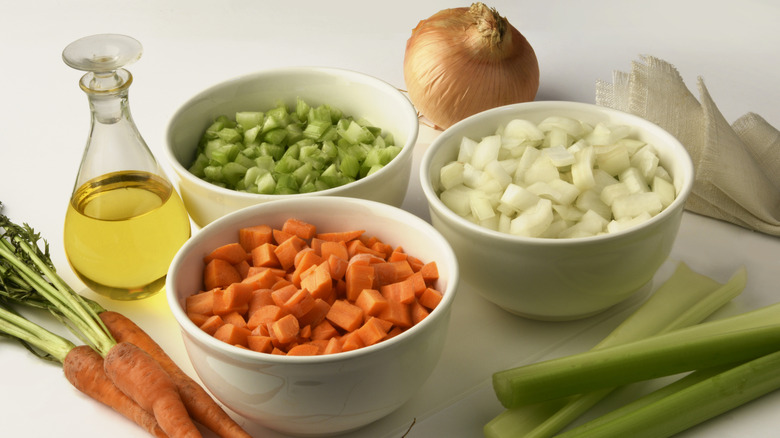Upgrade Soups, Sauces And Stocks With This 3-Ingredient Base (It's A Game-Changer)
Whether you're making a lazy home cook's Pomodoro sauce, a flavorful chicken stock, or you're whipping up a batch of simmering sopa de fideo (Mexican noodle soup), you're likely always looking for ways to improve upon your tried and true recipes. Isn't experimenting in the kitchen what it's all about? To get some tips on how to build a more flavorful dish, Foof Republic spoke to Marissa Stevens, recipe developer and culinary educator at Pinch and Swirl, to find out what she prefers to do in her own kitchen. And according to Stevens, there's one traditional technique that she swears by: using a mirepoix, diced onion, carrot, and celery.
Popular throughout various cuisines, a mirepoix is a combination of aromatics that allows you to layer in flavor from the start. While the term mirepoix is French, this same technique is called soffritto in Italian cuisine, and is also very similar to sofrito in Spanish. "Onions, carrots, and celery each bring something different — sweetness, aroma, and an earthy, subtle bitterness — they create balance," Stevens said. "You're not meant to taste it directly in the finished dish, but when it's done right, you notice how much more depth everything else has."
Tips for using mirepoix
While the traditional ratio is one part carrot and celery to two parts onion, Stevens said that you can feel free to adjust the amount of veggies based on your preferences. "I'll go heavier on carrots in tomato-based soups or sauces, or emphasize onion and celery for a cleaner-tasting stock," Stevens said. Additionally, Stevens mentioned that when she's making lighter dishes, she'll sometimes swap in shallots or leeks in place of yellow onions. "And when I'm leaning into Southern or Creole flavors, like in gumbo or Cajun-style potato salad, I use the 'holy trinity' variation — onion, celery, and bell pepper — instead." This version could also work as a base for a delicious classic Cajun jambalaya.
Once you're ready to make your mirepoix, Stevens said you want to make sure you cut your veggies small enough, since smaller pieces cook more evenly and release flavor faster. She also suggested keeping the heat low and steady instead of cranking it up too high. This is because mirepoix needs time to soften slowly (which is where sweating your vegetables comes into play). "When you rush it, the onions can taste sharp, and the carrots stay too firm," Stevens explained. "A gentle [saute] until everything turns soft and translucent makes all the difference."


